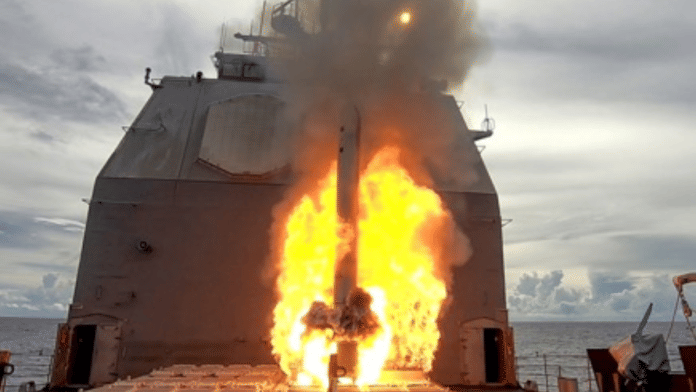New Delhi: As his country is locked in a war with Russia for over three years, Ukrainian President Volodymyr Zelenskyy made a transatlantic flight last week to Washington DC but failed to secure US-made Tomahawk missiles.
While Donald Trump had earlier hinted that he could provide the missile, the US President is said to have told Zelenskyy that he was not ready to supply it to Ukraine.
Trump’s U-turn came seemingly after an announcement was made that he would be meeting his Russian counterpart Vladimir Putin in Budapest, Hungary for a second summit on ending the war in Ukraine.
Earlier, the Kremlin had voiced “extreme concern” about the prospect of the US arming Ukraine with Tomahawk missiles.
Tomahawks would “enable the Ukrainian military to inflict substantial damage on key Russian military assets located deep within Russian territory, such as the Shahed drone factory in Yelabuga, Republic of Tatarstan, and the Engels-2 Air Base in Saratov Oblast,” according to American non-profit research group and advocacy think tank Institute for the Study of War (ISW).
ISW continues to assess that the Kremlin is waging a reflexive control campaign to deter the United States from authorizing the sale of Tomahawk missiles to Ukraine by threatening a deterioration in US-Russian relations.
ISW assesses that the US provisioning of Tomahawk missiles… https://t.co/g9u0WzR4IB pic.twitter.com/TomWt9peX1
— Institute for the Study of War (@TheStudyofWar) October 16, 2025
ThePrint takes a look at the missile that has been in the American military’s inventory since the 1980s and what makes it a prized weapon even today.
Precision at its core
Named after a Native American axe, the Tomahawk was pressed into action as recently as in June, when a US submarine fired over two dozen of them against Iranian assets during Operation Midnight Hammer. Last year, it was also used against the Houthis in Yemen.
While its development began in the early 1970s, the Tomahawk was first used in combat during the 1991 Gulf War. It is estimated that 288 of these missiles were launched to target Iraqi forces back then. Since then, the missile has been used to strike targets in Libya, Syria and Yemen among others.
U.S. Navy guided-missile destroyers from the Harry S. Truman Carrier Strike Group, operating in the Red Sea, launch Tomahawk Land Attack Missiles (TLAMs) at Iranian-backed Houthi command and control, weapon production and storage facilities in Yemen on December 31st, within the… pic.twitter.com/cGLffIHVEX
— U.S. Central Command (@CENTCOM) January 3, 2025
“The US and Allied militaries have flight tested the GPS-enabled Tomahawk over 550 times and used it in an operational environment more than 2,350 times,” reads the information provided by its manufacturer Raytheon.
The most recent versions, also called ‘blocks’, cost roughly $2.5 million each.
“The Tomahawk Land Attack Missile (TLAM) is an all-weather, long range, subsonic cruise missile used for deep land attack warfare, launched from US Navy surface ships and US Navy and United Kingdom Royal Navy submarines,” reads the description provided by the US Navy.
Simply put, Tomahawks are subsonic cruise missiles, which means they tend to fly at lower altitudes, with speeds less than that of sound (i.e., excess of 885 km/hr). What makes the Tomahawk a deadly weapon is not only its purported range of 1,600 km, but also its capability of loitering over a target area and accuracy of hitting a target within a scoping error of a few meters.
“The most recent version, called the Block IV Tactical Tomahawk, or TACTOM, has a data link that allows it to switch targets while in flight. It can loiter for hours and change course instantly on command,” Raytheon says on its website.
Capable of being launched from ships, submarines, and ground launchers, the turbofan powered missile mimics stealth using a combination of tools such as state of the art design and composite materials, fuel efficiency, less noise emissions, low-altitude fly-by and low speeds, thereby making it hard for radars to detect.
In layman’s terms, the Tomahawk hovers close to the ground to get an understanding of the terrain using two inbuilt features, namely TERCOM (Terrain Contour Matching) and DSMAC (Digital Scene Matching Area Correlator). This enables it to make route altering adjustments and derive the ability to reprogramme “in flight” to strike another target, additionally it can loiter over a target as well while it waits for further instructions.
The missile navigates to the target using a combination of GPS, which uses a host of satellites to calculate a precise location, and an Inertial Navigation System (INS), often used by navigators at sea as well to calculate position by measuring distance, direction and speed from the previous position.
Aided by these systems, the guidance system effectively relays instructions to the actuators (converts incoming electric signals into mechanical actions), allowing the missile to steer or perform evasive manoeuvres. The latest versions, on top of a warhead, have been outfitted with a submunitions dispenser or TMD (Tactical Munitions Dispenser), which carries a host of small, cylindrical explosives to specifically target airstrips.
The latest blocks have enabled a turnaround from instances of the Tomahawk veering off course. In 2003, 10 Tomahawks had crashed in Iran, Turkey and Saudi Arabia during Operation Iraqi Freedom. The US had then suspended launches of Tomahawks from ships in the Mediterranean and Red Seas.
Tejas Bhatotia is a TPSJ alum, currently interning with ThePrint.
(Edited by Tony Rai)
Also Read: China is the only nation gaining from Russia-Ukraine war. India must rethink multi-alignment






